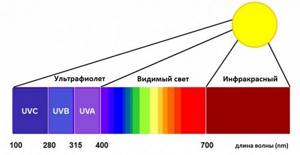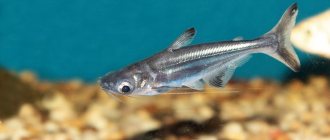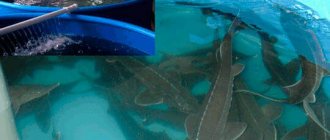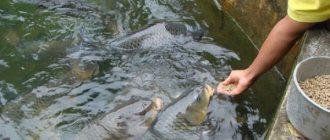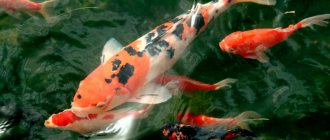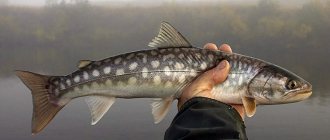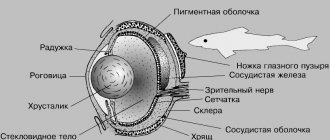A person receives over 90% of information about the outside world through vision - the remaining senses perform primarily an auxiliary function. Fish also see well, but the role of the organs of vision in their daily life is not so great: they rely more on smell, hearing, touch, and seismic sensory. However, the role of this sense organ cannot be underestimated: representatives of the shallow-sea ichthyofauna, deprived of the opportunity to see the world around them, will not be able to exist in natural conditions.
Today we will talk about the nuances of the structure of fish eyes and their perception of information. It is difficult for a person, even after going underwater and looking at the world directly or through the glass of a mask, to fully perceive the environment “like a fish” (we have a different structure and location of the eyes). But it won’t hurt the fisherman to get at least minimal information about the visual perception of the world by fish, because this will give an idea of the correct behavior when fishing, and sometimes the most rational choice of bait.
The structure of the eyes of freshwater fish
Actually, the principle of the structure of the visual organs in fish is not original: nature has tested it on most other vertebrates (amphibians, birds, mammals). That is, the eyes of most fish are structured approximately like those of a person: light hits the iris, passes through the pupil and is refracted at the lens. In turn, the lens supplies light to the retina, which consists of two types of photoreceptors (rods and cones). It is on the retina that the image that the fish sees appears.
This bait provides a rich catch even with a bad bite! More details Unlike humans, the pupil of most fish has a fixed size, that is, it is not able to increase or decrease under the influence of light (the pupils of only some marine predators, for example, sharks or rays, have this ability). Its shape can be either round or oval, even slit-like. The lenses of fish are usually spherical, occasionally slightly elongated, and more dense than those of land animals (remember that water is a denser medium than air).
The characteristics of the retina can be very different. Rods, which provide visibility in low light conditions, prevail in the retina of nocturnal and deep-twilight fish. Cones, responsible for visual acuity and color discrimination, predominate in diurnal species, the active phases of which take place in good light conditions.
Basic characteristics of fish vision
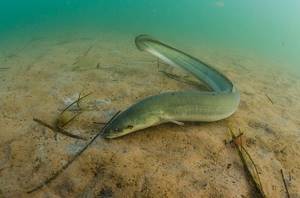
All fish have two eyes, and in most species they are located on both sides of the head. The exception is some marine species. As an example, we can cite stingrays with eyes positioned close to the front, or flounders - amazing flat-bodied fish whose visual organs are located on one, “upper” side. Eye movements are coordinated, that is, freshwater fish familiar to us are unable to rotate them, like chameleons.
Now let’s figure out what exactly fish are able to see in different conditions, and how their perception differs from what we are used to. Among the most important characteristics of visual perception of representatives of freshwater ichthyofauna (including aquarium fish) it should be noted:
- angle of view (monocular and binocular);
- ability to distinguish colors;
- range;
- differentiation of objects;
- perception of movement.
Let's consider each of the points in more detail, focusing on practical aspects.
Vision angle
Angle of view is one of the most important characteristics of visual perception, which, in addition to purely scientific, also has practical significance for the fisherman. What is most interesting is how the fish perceives a person on the shore.
As mentioned above, fish’s eyes are not located in front, like ours, but on the sides of the head. This determines the priority of monocular vision, that is, the fish perfectly sees everything that happens on the periphery, to the sides, above and below it, almost 150-170o. At the same time, the angle of binocular vision is small - about 30°. There are also so-called “blind spots” (mainly behind) that are inaccessible to consideration.
These laws work when representatives of the ichthyofauna examine underwater objects, but above water they undergo significant changes. Light is refracted differently in the air, so traffic at the water-air boundary plays a big role.
We won’t go into the details of optical physics, let’s just say: objects located on the shore at an angle of less than 45° are indistinguishable from representatives of the ichthyofauna. In other words, a person standing on the shore is visible to the fish, and he appears to her to be hovering above the surface. But this is not always the case when sitting, especially if he is located on a gently sloping bank. Moreover, this in no way correlates with the angler’s vision: he may not see a fish standing under a steep slope, while he himself is clearly visible to it, and vice versa.
It is also necessary to take into account the angle of incidence of light: the smaller it is (at sunset or dawn), the worse the fish distinguishes objects located on the shore. And if at least some wave rises on the surface, surface objects will become completely indistinguishable to the inhabitants of the water.
From this we can draw conclusions:
- When fishing, you should avoid sudden movements, especially if you are sitting on a high bank or standing up. Less caution in this regard can be observed at sunset and dawn, as well as in the presence of waves.
- It's better to go against the flow. The fish stands with its head predominantly facing the current, and a fisherman approaching from behind falls into a blind spot.
- You need to remember: the fish may not be able to distinguish you visually, but they can hear you perfectly well, so sharp sounds should be avoided if possible.
Color discrimination
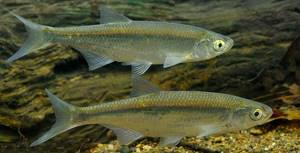
Ichthyologists differentiate freshwater fish according to their lifestyle into light-loving and nocturnal (between them lies a mass of intermediate crepuscular species). Let’s not focus on the scientific classification, just say: diurnal species distinguish colors very well (some see shades almost on a par with humans), nocturnal fish see the world primarily in black and white, but are able to distinguish the contours of objects in almost complete darkness.
As a result, diurnal and twilight-diurnal (their retinas have more cones) fish become accustomed to relying on vision, while deep-twilight and nocturnal (practically devoid of cones) fish become accustomed to relying on other senses.
This means that when hunting for twilight-day perch or pike, the color of the bait is important, while when catching pike perch or catfish, this characteristic does not play a role - the main thing is sound effects and movement. However, if the bait sharply contrasts in color with its surroundings (for example, white or yellow), the same pike perch is more likely to react to it than to a dark-colored model.
However, it must be borne in mind that almost all fish are able to see polarized (that is, reflected) light. This is important both for peaceful schooling representatives of the ichthyofauna, and for predators reacting to the reflections of the scales of potential prey. This explains the effectiveness of some spinners on the simplest uniform retrieve. Distinguish between fish and ultraviolet. But representatives of freshwater ichthyofauna, in most cases, do not favor electric light. It has been experimentally proven that when fishing for the same perch at night, there are significantly fewer bites in the illuminated area than in the unlit area.
The ability of fish to distinguish colors is also evidenced by their desire for mimicry: they prefer to stay in areas where their color blends with the environment. The most telling example is flounder. Probably everyone has heard that it can change the color of its scales depending on the color of the bottom surface on which it lies. Flounder can even imitate a chessboard! So, as soon as this fish is deprived of the opportunity to see the world around it, its ability to mimic immediately disappears!
Conclusion: it is better not to dress in bright clothes, because anything unusual that stands out from the general picture is perceived with caution by the fish. This is especially important when fishing during daylight hours.
Distance

The rounded lens also determines other visual features of representatives of the ichthyofauna. Sometimes it protrudes beyond the cornea, which helps to expand the viewing angle, but does not improve visual acuity at all.
For the most part, fish are more myopic than mammals. However, a person without a mask under water also cannot boast of falcon vision: the distance of object recognition and image clarity suffer significantly due to the characteristics of the aquatic environment. Some fish see better (mostly daytime fish), some worse, but there are no champions in the corresponding category among them.
And now some numbers. Most fish are able to distinguish the contours of objects at a distance of 10-12 meters (in clear water and good lighting). However, they can only examine details (shape, color and other characteristics) at a distance ten times smaller. For example, a perch will see a centimeter object 5 meters away, but will be able to examine it in detail at a much closer distance.
Conclusion: the appearance of the bait can play a certain role only at a distance of 1-5 m (depending on its size and degree of water transparency). At greater distances, the main role is given to smell, seismosensory and hearing.
Object differentiation
It was found that fish can distinguish and group objects based on external features (however, here we are talking more about intellectual conditions than about the vision of fish). During food training, it was found that they are quite capable of distinguishing a cube from a pyramid or a ball from, for example, a cylinder.
It was also found that some fish are able to externally distinguish members of their group (herring, perch, and so on), and recognizing a predator “by sight” is absolutely necessary for survival. By the way, some tropical fish choose partners once and for life: they are able to recognize them from thousands of their own kind.
As a rule, all objects that a fish sees are immediately classified in its brain and fall into a certain category. Insignificant objects are cut off, the rest are divided into potentially dangerous (causing wariness or immediate flight) and attractive (associated with food, living together or reproduction).
Conclusion: the ideal option for a fisherman is to be classified as a neutral, non-hazardous object. That is, you should not stand out from the surrounding visual and audio environment.
Motion perception

Fish perceive immovable objects worse - any spinner will tell you this. It is the activity of potential prey that forces the predator to attack. In this case, everything is important: the shine of the scales, the trajectory of movement, and other visual effects. Additional sound effects are also good to enhance them. This explains the success of hunting pike perch with all sorts of “rattles”, the attractiveness of wobblers with “chomping” effects, and the widespread use of “quoka” for hunting catfish.
However, even peaceful fish are able to see a predator threatening it and retreat from the dangerous sector in time. She recognizes the beginning of an attack by the characteristic twitching of the fins, which precedes the attack of the predator.
The speed and detail of the fish’s reaction to movement is determined by the characteristics of vision and the nervous system. Some representatives of the ichthyofauna (bleak, crucian carp) react to movement in less detail than humans, perch and bream - almost twice as detailed and faster. By the way, the famous “toothed torpedo” (that is, the pike) perceives movement in approximately the same way as a person.
It has been proven that well-fed and tired fish have a slower reaction to movement, while hungry and rested fish have a faster reaction. This explains the mechanics of the famous pre-spawning meal: the fish are hungry and respond well to moving baits.
Smell
Along with hearing and vision, fish also use chemoreception to smell chemical traces in the water around them. In most cases, this is done through cells in the nostrils, although some species, such as catfish, have receptors distributed throughout the body, allowing them to taste anything they touch.
These chemoreceptors are often unusually sharp. Sometimes they are used for hunting. Sharks, for example, can detect blood at levels as low as one part per million, allowing them to smell prey over long distances. An indication of the importance of this ability can be found in the fact that in aquatic creatures, an astonishing 14% of the total brain mass is devoted to the sense of smell.
Thailand: Santa on an elephant gives masks to residents of the country, and let the deer rest
The famous singer of Romania of the 20th century composed the song “Infection”: to whom is it dedicated?
Karpovich posted a joint photo with Priluchny for the first time amid rumors of a breakup
Chemoreceptors also play an important role in migration: salmon recognize the scent of the stream in which they were born, and they later follow threads of that scent back to the same section of the river.
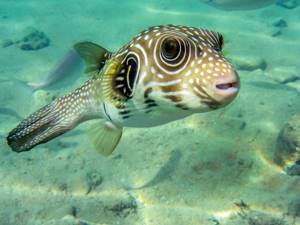
Peculiarities of fish behavior depending on vision
Let's consider the behavior of the most popular predators of our reservoirs, determined by the peculiarities of vision.
Perch and pike are able to hunt almost around the clock, but with varying intensity and degree of success. In summer, the most productive hours for them are the dawn and evening hours, when these fish see potential prey most clearly. This is approximately 3-4 hours of effective hunting. At night, the illumination decreases, and potential prey moves out of sight, becoming almost indistinguishable.
As the sun rises to the horizon, the perch and bleak flock together in defensive flocks, which appear to predators as a continuous sparkling monolith, where it is impossible to isolate a specific object of attack, which makes hunting difficult. And a large flock has a much greater chance of noticing danger. During this period, pike and humpback perch switch exclusively to ambush hunting, that is, they lie in wait for prey in a secluded place. They attack only if they have a clear view of the prey and are guaranteed to be able to catch it in one rush. The element of persecution is excluded. When autumn comes, the schooling small fish do not form such dense groups, so these predators can chase them throughout the daylight hours.
With pike perch the situation is somewhat different. Thanks to the presence of a special substance in the retina, guanine, these fish are able to see in almost complete darkness. But freshwater cod practically does not distinguish colors, and it does not differ in visual acuity, since there are frankly not enough cones in its retina.
Interesting facts about fish with a “special” eye structure
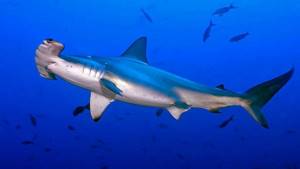
Now let's talk about the visual features of some representatives of the ichthyofauna. This information is unlikely to be useful when fishing, since it concerns mainly exotic fish, but it is of some value for general development.
- Four-eyed fish . No, in fact, this amazing fish has two eyes, but each of them is divided into two parts. The first is optimally designed for the perception of visual information under water, the second, above it. This representative of the ichthyofauna lives near the surface and lies in wait for insects that carelessly land on them. At the same time, the lower “pair of eyes” monitors the aquatic environment for the appearance of a natural enemy.
- Deep-sea species . The deeper into the water, the darker it is - this is understandable. This led to the formation of special tubular eyes in some species with very large lenses and a retina consisting of only rods. This improves binocular vision and allows you to successfully recognize the silhouettes of potential prey. Fish that live at very great depths do not see at all: you cannot see anything in the depths of the ocean, so they have to rely on other sensory systems.
- Sharks . The eyes of sharks are designed remarkably: not only are their pupils able to adapt to the level of illumination by changing sizes, but the storm of the oceans also has “eyelids”! Sharks do not blink (there is no need to wet the cornea under water), but during an attack, the eyes of predators are protected by dense membranes. Some species whose eyes lost membranes during evolution have learned to turn their eyes back to protect them. But what nature has done most surprisingly is the design of the hammerhead fish’s eyes (by the way, this is also a shark). Its eyes are spaced on the sides of its hammer-shaped muzzle. As a result, binocular vision is practically absent, the “blind spots” are large, but the organs of vision are not exposed to attack during an attack on the main prey - stingrays.
- Flounder . Another amazing fish in every way. Unlike most other representatives of the ichthyofauna, it loves to rest on the bottom (negative buoyancy allows this). As mentioned above, this fish is able to reproduce the bottom topography seen on its own skin, completely merging with the environment. The eyes located on the outside are directed upward. Interestingly, flounder fry do not in any way resemble this natural surrealism: they have the usual shape and arrangement of eyes for fish, a swim bladder and even a miniature spine for protection from dangers. At one point, they lose this “normality” and lie on the bottom, lying in wait for prey and moving only if necessary.
- Butterfly fish . This fish is a true intellectual and a standard of loyalty among its own kind. It is she who chooses a partner for life and spends all the time with him, never confusing him with other representatives of her species. Moreover: in the process of evolution, butterflies acquired imitation eyes, located on the sides of the body closer to the tail. These “eyes” are very large, which often warns the predator from attacking: he thinks that such an impressive prey is too tough for him. But if he suddenly decides to attack, another surprise awaits him: a butterfly flies away in an unexpected direction, with its “eyes” back!
We hope that this publication helped you learn a lot of little-known information about representatives of the ichthyofauna. Sometimes even well-known species of fish can sincerely surprise experienced fishermen, let alone the scaled originals mentioned here!
Fishermen wonder why I’m biting and they’re not?
I’m revealing a secret just for you: it’s all about the miracle bait! More details
Infravision
Some—especially freshwater fish—can see in the infrared, which makes it easier for them to see in the murky, red-colored waters of rivers and lakes. Others are able to see ultraviolet light, and some - polarized light. Some even have visual worlds that change over the course of their lives: salmon's eyes, for example, are calibrated to better see blue when they're in the ocean and red when they're in fresh water.
Astrologers explained why January 11 will be a good day for everyone
Leonardo DiCaprio and Jennifer Lawrence continue filming after a long break
Valeria's 22-year-old son flew off on vacation, leaving his wife and baby at home
